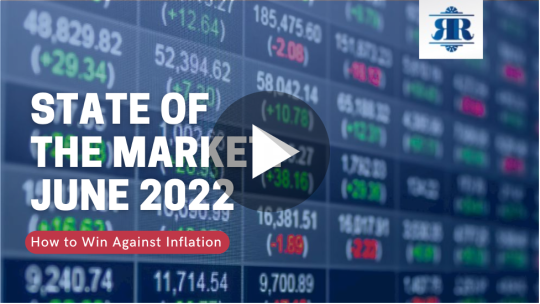
Posted June 09, 2022
By Zach Scheidt
The Key to Winning Against Inflation
It’s warming up here in my hometown of Atlanta, Georgia. And just last weekend my HVAC unit stopped working.
As it turns out, we blew a capacitor that now needs replacing.
The problem is that thanks to supply chain shortages, it’s going to take a while until the replacement parts arrive.
With the warm weather and humidity, I know I’d be willing to pay more if I could get my hands on a replacement part right now.
Unfortunately, it sounds like I may be out of luck.
Of course, this is just one example of how shortages and supply chain disruptions are affecting all of us these days.
It’s also a pretty good illustration of how shortages lead to inflation.
This week, I sat down in the “hot seat” (forgive the pun) with my colleague J-Rod to discuss how supply chain disruptions are contributing to inflation.
And we also talked about the opportunities in the stock market that can help you beat inflation and protect yourself from rising costs.
Click on the video below to check out our conversation.
Video Notes:
Supply chain disruptions are continuing to cause problems for both businesses and individuals. And the shortages that these disruptions create fuel further inflation.
When consumers need something but there’s less of it available, they’re willing to pay more to get their hands on the item that they need.
That willingness to pay more drives prices higher. And this is just one of the many factors causing inflation right now.
Of course, these challenges affect all of us. But inflationary pressure hits some people harder than others.
For instance, lower-wage earners are especially hurt by inflation, because they’re less able to afford rising prices.
And inflation also hits the elderly harder than others since they’re often on a fixed income.
These individuals have worked hard to build savings to retire on, but now they’re facing higher costs of living while their savings dwindle.
Unfortunately, inflation is like a tax placed on those who can least afford it.
My hope is that if you’re watching today’s call, you can better understand what’s going on and learn how to invest to offset the higher costs of inflation.
The good news is that we are starting to see inflation cool down some, which is helping to support the market.
But don’t think that you don’t have to worry about inflation now that it appears to have peaked. Even if the rate of inflation slows down somewhat, prices are still high and continue to rise.
That’s why it’s so important to be proactive with your investments to protect yourself from inflationary pressure.
Fortunately, there are plenty of opportunities in the market to do just that.
If you know where to invest, you can grow your income so you have more cash to put toward rising prices.
And you can even beat inflation to grow your wealth even more.
One of the things I see that’s encouraging is that price-to-earnings ratios are back in focus.
Essentially, this just means that investors are becoming more concerned with how much value they’re getting for their investment dollars.
That brings us back to one of the fundamentals of investing: you need to know what you’re buying when you buy a stock.
You want to remember that when you buy a stock, you’re buying a business.
Gone are the days of buying shares of an exciting tech company in a cutting-edge industry that doesn’t actually generate profits.
Instead, we’re looking at a company’s underlying business (revenue, debt, growth opportunities, and dividends) to see if it’s worth holding in our portfolio.
One way to determine the value of a company is to look at its price-to-earnings (P/E) ratio — or how much you’re paying to buy the stock compared to the earnings the company expects to generate.
It’s been a long time since we’ve been able to buy quality stocks at a discount price using this metric. But that’s beginning to change.
Looking ahead, that means when you buy stocks at a low P/E ratio, your returns over the next several years should be much higher.
On the other hand, when you buy relatively expensive stocks, your returns will likely be much smaller.
Personally, I’m excited to see that we’re getting better deals on the stocks that we buy. But at the same time, we do also have to be more careful about where we’re investing.
Mega-cap stocks like Microsoft, Apple, or Amazon — even if they’re good companies — won’t get you the best value for your investment dollars.
And you can find a company’s P/E ratio on most free online tools like Yahoo Finance or Finviz.
Bottom line: we’ve all got to be more selective investors now.
You can’t just invest blindly in an S&P 500 fund and hope for the market to head higher. Instead, you have to be more careful with what stocks you’re buying.
If you are more selective about where you invest, I’m confident that you can still do well in an inflationary environment.
So I encourage you to sell your shares of speculative tech stocks and move your capital into solid companies that generate solid profits — preferably ones that pay a dividend so you can earn income quarter after quarter.
That’s how you win in a turbulent inflationary environment. And it’ll help you sleep easier at night knowing your portfolio is working for you.
Here's to living a Rich Retirement,

Zach Scheidt
Editor, Rich Retirement Letter
RichRetirementFeedback@StPaulResearch.com

How Others’ Incompetence Costs You Big-Time
Posted January 17, 2024
By Byron King

Turning Empty Cubicles Into Houses
Posted January 15, 2024
By Zach Scheidt

"Boring AI": Overlooked Opportunity From CES 2024
Posted January 12, 2024
By Zach Scheidt

5 Must-See Predictions
Posted January 10, 2024
By James Altucher

Welcome to Earth, the Mining Planet
Posted January 08, 2024
By Byron King

